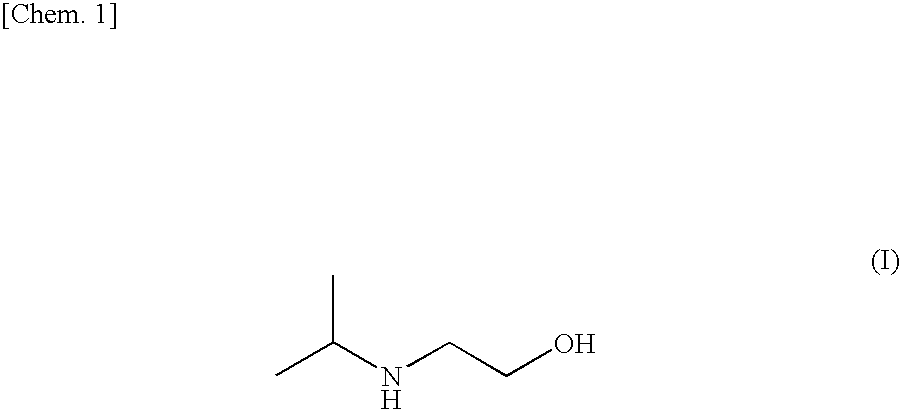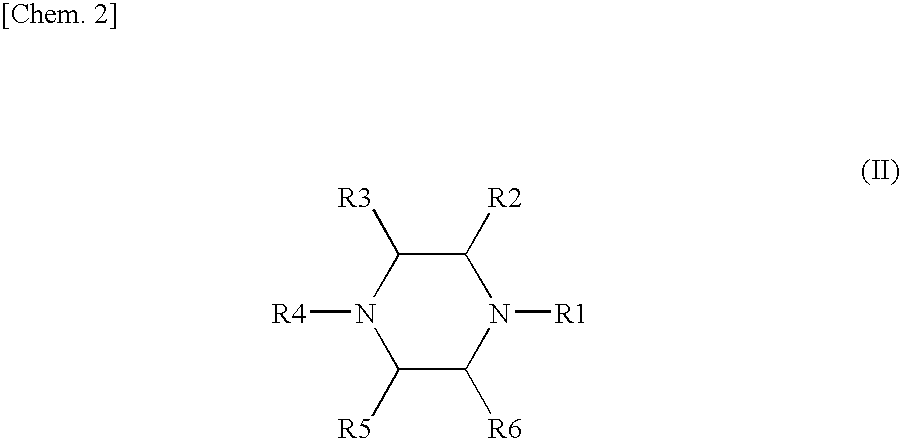Method for efficiently recovering carbon dioxide in gas
a carbon dioxide and gas recovery technology, applied in the field of carbon dioxide recovery, can solve the problems of high energy consumption, difficult to separate the absorbed carbon dioxide, and high energy consumption, and achieve excellent excellent carbon dioxide separation performance, and good balance between carbon dioxide absorption performance and carbon dioxide separation performan
- Summary
- Abstract
- Description
- Claims
- Application Information
AI Technical Summary
Benefits of technology
Problems solved by technology
Method used
Image
Examples
case 1
, in which Other Amine is a Main Component, and IPAE is an Accessory Component
[0074]The following Examples show cases in which an aqueous solution of other amine is modified by replacing part of other amine with IPAE, or adding a small amount of IPAE as an additive.
example 1
[0075]A glass gas absorption bottle was immersed into a constant temperature water bath whose liquid temperature was set to 40° C. This bottle was filled with 50 ml of an aqueous solution containing 10 wt. % of IPAE and 20 wt. % of PZ. A mixed gas containing 20 volume % of carbon dioxide and 80 volume % of N2 was dispersed as bubbles into this solution at a rate of 0.7 l / min through a glass filter with a pore size of 100 μm and a diameter of 13 mm at atmospheric pressure to cause absorption.
[0076]The CO2 concentration in the gas was continuously measured at the inlet and outlet of the absorbing solution using an infrared carbon dioxide meter (HORIBA GAS ANALYZER VA-3000). The amount of CO2 absorbed was determined from the difference between the CO2 flow rate at the inlet and the CO2 flow rate at the outlet. When necessary, the amount of inorganic carbon in the aqueous solution was measured using a total organic carbon meter for gas chromatography (SHIMADZU TOC-VCSH), and compared wi...
examples 2 and 3
[0078]Using aqueous solutions containing IPAE, piperazine (PZ), 2-amino-2-methyl-1-propanol (AMP), and N-methyldiethanolamine (MDEA) in the concentrations shown in Table 1, the amount of CO2 absorbed to saturation, the absorption rate, the amount of CO2 separated, and the separation rate were measured using the same equipment and conditions as in Example 1. Table 1 shows the results.
PUM
| Property | Measurement | Unit |
|---|---|---|
| Temperature | aaaaa | aaaaa |
| Temperature | aaaaa | aaaaa |
Abstract
Description
Claims
Application Information
 Login to View More
Login to View More - R&D
- Intellectual Property
- Life Sciences
- Materials
- Tech Scout
- Unparalleled Data Quality
- Higher Quality Content
- 60% Fewer Hallucinations
Browse by: Latest US Patents, China's latest patents, Technical Efficacy Thesaurus, Application Domain, Technology Topic, Popular Technical Reports.
© 2025 PatSnap. All rights reserved.Legal|Privacy policy|Modern Slavery Act Transparency Statement|Sitemap|About US| Contact US: help@patsnap.com



